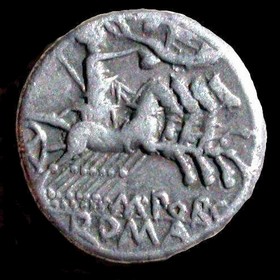The denarius on the left of
M. Porcius Laeca (125 BC) displays on the reverse Libertas driving a quadriga, holding a pileus and a sceptre, crowned by a flying Victory. On the imperial coinage of Claudius she is usually portrayed standing and facing, holding the cap of Liberty (pileus), flanked by the monogram SC (by degree of the senate). From Galba on she appears variously as Libertas Publica, Libertas Populi Romani, and Libertas Augusta as a reverse type. Liberty is portrayed standing with a sceptre and pileus, her tunic gathered in with a sash, her mantle draped around her legs and hanging loose from her shoulder - probably modelled on a statue from the late classical period. During the late-Empire, as shown on the reverse of an
antoninianus of
Trebonianus Gallus (right) Liberty still features as a popular reverse type - holding a pileus and a sceptre, with a star in the right field.
